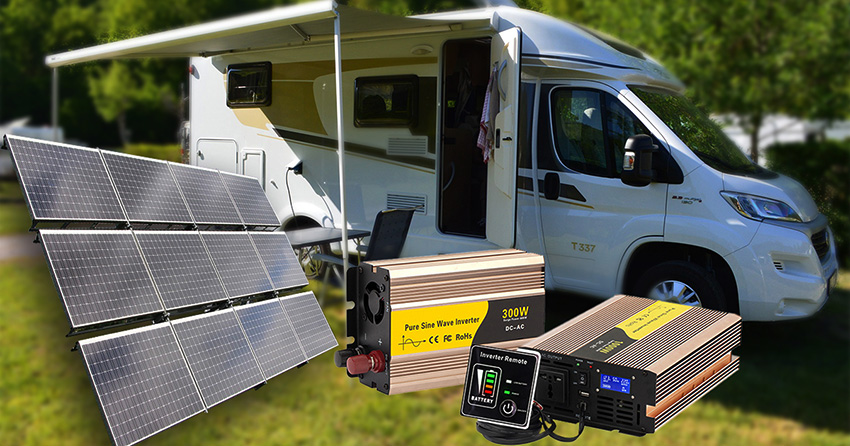Custom Solution in Recreational Vehicle
Solar power systems for RVs (recreational vehicles) have gained popularity due to their eco-friendliness and independence from traditional grid power. These systems typically consist of solar panels, a charge controller, batteries, and an inverter. Solar panels, usually mounted on the RV's roof, capture sunlight and convert it into electricity. The charge controller regulates the power flow to prevent overcharging the batteries. Deep-cycle batteries store this energy, ensuring a continuous power supply even when the sun isn't shining. An inverter converts DC power from the batteries into AC power, allowing you to run appliances and charge devices. In the following, we introduce related case about RV.

First, placement of front and rear beds.
Placement of front bed. After the seat is flat forward, the hard wood board can be fixed on the back of the seat to make the bed surface, and the fixed screw can be rotated mainly, so that the owner is relatively high randomness. Then, the cabinet cover plate is turned over, the scale specification of the bed is about: 1.25*1.8 meters. That solves the problem of using the bed.
Placement of the back bed. The rear seat for 2 people can be set up as a kitchen, the left door is set up as a cabinet for pots and pans, the right door cabinet is a microwave oven, and next to the wheel hub is a stainless steel water tank. The dinette can pull a power cord that takes care of electric cooking. If the chairs are opened up, the space can be turned into a place to cook and do homework. The back cover can be flipped into a 1.22*1.8 meter bed. Caravan living is equipped with basic setup: inverter, kitchen stove. Stainless steel is bent to make a tray, and the cover opens and closes by a strong magnet.
Two taps are mounted in the left center, one to the tank for washing water and one for direct drinking water, with drawers and a fridge underneath. The whole space under the sink becomes a storage room for odds and ends, maximizing the use of space. Better yet, customize a 50-liter fridge in which the car battery is connected directly to the fridge's power supply. Your fridge will be electrified, allowing you to enjoy fresh ingredients and cold drinks in the summer.
Second, installation of off-grid roof tent.
The top of the car is made of luggage rack. The top height of the car is 2345 mm, and it needs to ensure that it does not exceed 2500 after installation. Therefore, the false height of the frame is 130 mm. The skylight of the bus is opened at the back just not to damage the structure of the bus, the skylight is used as an escape window and air exchange function, because the ventilation hole is only a slit of two millimeters wide and 80 millimeters long, it can not be used as an exhaust fan, increase the ventilation hole to 12 mm *80 mm to ensure good ventilation.
Add solar energy off-grid inverter, a single block of scale 1200*540, 2180*1200 mm after combination is fixed in the structure, structure 50*3 angle steel (preferably aluminum alloy), between the panel and Angle steel with 3 mm rubber, structural glue, 8 mm screw connection, glass glue seal. The waterproof tent fabric is connected to the structure with adhesive, and the tent roof is made of herringbone roof, two 100kg 1m long poles, and the front hinge is connected to the structure.
The solar panel assembly is embedded in the luggage rack, which is made of 1.5 mm thick cold-pressed steel, bent, welded and painted. 88 mm screws are fixed in the car reinforcement, pad 50*50*10 mm rubber, does not affect the water, there is a ring frame and the whole ring of the roof touch, sealant seal, the board frame is smaller than the solar panel structure, so the water will not enter the inside, the roof punching structure glue seal.
Third, electrical part.
Five 120W solar panels, two 200A batteries, under the passenger seat, 3000W pure sine wave solar inverter in the middle of the two, and the controller can be mounted in a convenient place, which is both beautiful and practical.
The electromagnetic switches, relays and control switches are all installed on the passenger side. Use the direct relay in the positive and negative switch, the top is connected to the main battery, the bottom is connected to the secondary battery, and the upper and lower are disconnected, so that the main and secondary batteries are completely separated. When driving, the top is often closed and connected. When the main battery is not powered, it needs to borrow the deputy battery to start the car before closing down. After the car, the relay will operate, the electromagnetic switch is connected, and the main and deputy batteries will be charged together.
